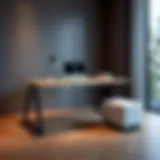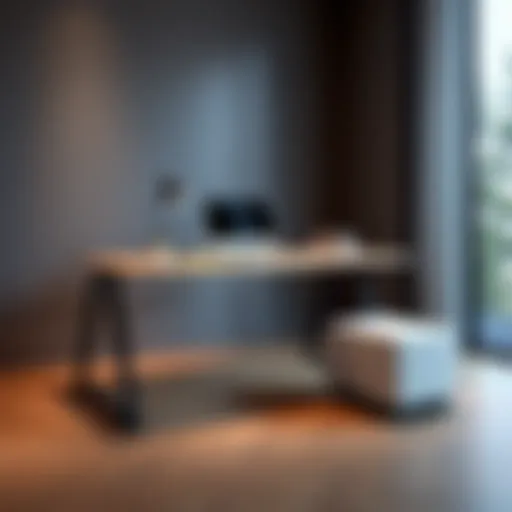Creating Inviting Outdoor Patios in Small Areas


Intro
In our increasingly crowded urban jungles, the aspiration for private outdoor spaces often feels like chasing shadows. Homeowners tend to search for ironclad solutions that can seamlessly blend comfort with functionality. Small patios, while they may seem restrictive, offer unique opportunities for creativity and design ingenuity. It’s about transforming those neglected corners into vibrant retreats where one can unwind after a frenetic day.
Realistically speaking, the whole notion of maximizing limited outdoor areas goes beyond mere aesthetics—it dives into strategic planning encompassing furniture choices, layout efficiency, and even an understanding of how greenery enhances the atmosphere. This article aims to provide a roadmap for anyone eager to reimagine their small outdoor spaces into stylish and practical havens.
Furniture Styles and Trends
The heart of any successful outdoor patio design often lies in the furniture. Choosing the right styles and staying abreast of current trends can make a world of difference in a compact area.
Exploring Popular Furniture Styles
Believe it or not, the market is brimming with a variety of furniture styles that can complement small outdoor areas. Mix-and-match trends can provide character without overwhelming the space. For instance:
- Modern Minimalism: Offers sleek lines and understated elegance. Think lightweight metal chairs or a glass-top table that visually balances the area.
- Rustic Charm: Infuses warmth with natural wood elements, which evoke a cozy feel. Look for weather-resistant timber furniture that won’t break down in the elements.
- Sustainable Products: There’s a growing trend towards eco-friendly materials. Rattan or bamboo furniture not only provides a unique texture but also aligns with environmentally-conscious choices.
Understanding Current Design Trends
Current trends are heavily influenced by lifestyle changes and technological advancements. Here are a few noteworthy currents in outdoor design:
- Multipurpose Furniture: Just like a Swiss Army knife, pieces that serve more than one purpose are what people lean towards. Think ottomans that double as storage or tables that can be adjusted for dining or coffee.
- Vertical Gardens: Why limit greenery to the ground? Wall-mounted planters and vertical racks can not only save space but also add lush aesthetics.
- Textured Fabrics: Outdoor fabrics have come a long way. Embracing textures can add depth and richness, making the space feel inviting while remaining practical.
"Design is not just what it looks like and feels like. Design is how it works." - Steve Jobs
Practical Tips for Furniture Selection
Investing in outdoor furniture isn’t just about looks; it’s also about making informed choices that fit your limited area.
Factors to Consider When Choosing Furniture
When selecting items for a small patio, consider:
- Scale: Always match furniture size to the space. Oversized pieces can make an area feel cluttered.
- Durability: Since these pieces will face weather, select options made from weather-resistant materials like aluminum, teak, or synthetic wicker.
- Comfort: There’s no point in having outdoor spaces if they’re not comfortable. Cushions with water-resistant covers can bolster both comfort and style.
How to Measure and Optimize Space
A well-laid plan is key to maximizing function:
- Take Accurate Measurements: Use a tape measure to quantify the area before making any purchases. A properly measured space informs decisions and helps avoid costly mistakes.
- Layout Planning: Employ a sketch or design software to visualize the arrangement before committing to furniture.
- Traffic Flow: Ensure there’s enough space to move around comfortably. Leave pathways open between furniture to avoid feeling cramped.
By understanding furniture styles, leveraging current design trends, and weighing the practical aspects of selection, homeowners and designers can craft inviting outdoor retreats from even the most restricted spaces.
Understanding Small Outdoor Spaces
In today’s fast-paced world, especially within crowded urban settings, the significance of outdoor spaces cannot be understated. Brief interludes in nature can breathe fresh life into our hectic schedules. Even in the confines of compact homes, a thoughtfully designed patio can serve not merely as an extension of each person’s living area, but als as a personal sanctuary. It enhances not only property value but also quality of life.
Defining Small Outdoor Areas
When we talk about small outdoor spaces, we’re diving into a realm where creativity meets practicality. Small patios, balconies, or even micro gardens can range from diminutive balconies overlooking cityscapes to cozy nooks squeezed between buildings. The size may be modest, but with the right design, it can fulfill the role of a large external living space. This is about maximizing every inch available through intelligent arrangement and innovative concepts.
These areas often pose unique opportunities. For instance, a tiny balcony can be transformed into a romantic getaway with twinkling lights and plant life. Such projects can embody the charm of outdoor spaces without the necessity of sprawling expanses. This leads to more sustainable living choices, where fewer resources are utilized, and smart design plays a crucial role.
Common Challenges
Designing in limited areas isn’t without its set of hurdles. Homeowners frequently encounter a variety of constraints, both physical and aesthetic. Here are several common challenges that arise when dealing with small outdoor patios:
- Limited Space: The obvious challenge of restricted square footage demands careful planning. Every piece of furniture or accessory needs to earn its place, ensuring that it enhances functionality without overcrowding.
- Lack of Privacy: In bustling neighborhoods, privacy can be elusive. This potential lack of seclusion may diminish the enjoyment of the space.
- Storage Concerns: Smaller areas often do not have sufficient storage for tools, cushions, and supplies, creating a cluttered atmosphere if arrangements aren’t made.
- Maintenance: In a tight space, upkeep can sometimes turn into a daunting task. Multiple elements such as plants, furniture, and textiles need a cohesive maintenance strategy to ensure they stay inviting.
Navigating these challenges requires thoughtful approaches. Integrating vertical gardening concepts and selecting multi-functional furniture significantly elevates the design’s potential. Ultimately, understanding these obstacles gives homeowners the tools they need to engage creatively with their small outdoor spaces and forge designs that are both stylish and functional.
"Designing small outdoor spaces is not just a challenge; it’s an invitation for clever and creative solutions that enhance our living environments. "
Key Principles of Designing an Outdoor Patio
Designing an outdoor patio in a limited area requires attention to various principles that maximize functionality and enhance aesthetics. These principles are essential in transforming a compact space into a cozy retreat. Effective space utilization can create a comfortable area that serves multiple purposes, whether for relaxation or entertaining guests.
Thoughtful design of small outdoor spaces means considering every element. This is particularly crucial in urban settings where space often feels constrained. It’s not just about fitting furniture into an area; it’s about crafting an experience that complements the essence of outdoor living. A well-planned patio can provide a sense of openness, making even the smallest areas feel inviting.
Functional Layout
A functional layout is the backbone of any successful patio design. This means arranging furniture and accessories to facilitate movement and to create zones for different activities. You wouldn’t want a cluttered space where one can hardly squeeze in a chair without knocking over a potted plant. Instead, think about the flow — how one moves from the outside world into this snippet of calm.
- Defining Zones: Start by identifying distinct sections. Maybe one corner houses a bistro table for alfresco dining, while another hosts a lounge chair for solo reading. Establishing these areas helps in visualizing the space effectively.
- Scaling to Size: Always choose furniture that fits the space. Oversized chairs or extensive dining sets can overwhelm a patio, making it feel cramped. Instead, consider sleek designs that are easy to maneuver.
- Walking Path: Ensure that there’s a clear path for moving around. An obstacle-free walkway not only enhances accessibility but also contributes to an overall pleasant atmosphere.
Furniture arrangement has to prioritize usability. If you envision hosting some gatherings, leaving enough room between seats can make a world of difference. Guests shouldn’t feel like they’ve stepped into a sardine can. A patio needs to blend functionality without sacrificing style.
Aesthetic Considerations
While functionality is key, aesthetics should not be overlooked. The outdoor space reflects the homeowner’s personality and style. Therefore, a properly designed patio should not only be practical but also visually appealing.
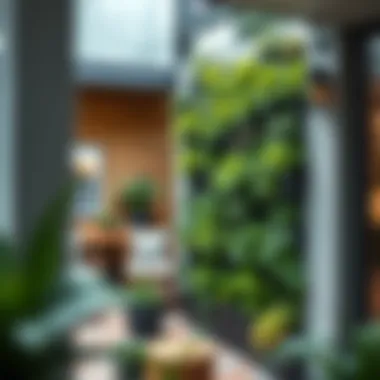

- Color Palette: Lively colors can rejuvenate a space. However, in smaller areas, muted tones can promote a sense of calm. Soft blues, greens, or earthy shades usually work well, providing an open feel.
- Textures and Materials: Mixing materials—think wooden tables paired with steel frames or soft textiles against stone—adds depth and interest. Using various textures can also create visual contrast, enhancing the overall design.
- Personal Touches: Artful accents speak volumes. Hanging lanterns, small sculptures, or local crafts can add a charm that resonates personally. They breast the line between function and style, making the space distinctly yours.
Remember, it's oftentimes the small details that leave a lasting impression.
Thus, integrating these principles—the layout that flows purposefully and appealing elements—creates a cohesive space that serves all needs and expresses personal character. Striking the right balance elevates the outdoor experience, even in the tightest of quarters.
Selecting the Right Furniture
Choosing the right furniture is an essential part of designing an outdoor patio, especially in small spaces. The right pieces can make all the difference, transforming a cramped area into a cozy retreat. This selection process involves considering not just the style, but also the functionality of the furniture to ensure it fits seamlessly into the available space. Prioritizing furniture that has smart design and purpose will help maximize the space effectively.
Space-Saving Solutions
When it comes to making the most out of limited areas, space-saving solutions take center stage. They allow homeowners to enjoy stylish and practical outdoor living without cluttering the area.
Foldable Furniture
Foldable furniture is like the Swiss army knife of outdoor design; it brings flexibility to small patios. The standout feature of these pieces is their adaptability – they can be easily collapsed and stored away when not in use. This characteristic makes them popular among urban dwellers who value both form and function.
One might consider a foldable dining table that stows away neatly against the wall or a collection of foldable chairs that can be tucked away after an alfresco meal. These advantages allow homeowners to reclaim precious space quickly, transforming their patios for various occasions. However, one downside to note is that while they can be space-efficient, foldable items sometimes sacrifice sturdiness for portability.
Stackable Chairs
Stackable chairs offer similar benefits to their foldable cousins but with a twist. These chairs can be neatly piled up, which is ideal for saving ground space when not in use. The true beauty lies in their ability to maximize seating capacity without necessitating vast amounts of square footage.
They work well in social gatherings or family BBQs, easily accommodating extra guests when needed. Moreover, stackable chairs come in numerous designs, which means style doesn't have to take a backseat to practicality. One thing to keep in mind, however, is that over time, stacking can wear down the materials if not handled gently.
Multi-Functional Pieces
Multi-functional pieces are like the hidden gems of outdoor furniture design, seamlessly marrying comfort with versatility. These items, such as benches with hidden storage or ottomans that double as tables, enhance utility without demanding a lot of space. They cater to different needs without the requirement of excess furniture.
For instance, a storage bench not only provides seating but also offers a place to stash garden tools or cushions. This trait is particularly appealing for those keen on keeping their outdoor areas tidy. However, homeowners should be cautious; the complexity of some multi-functional pieces can mean that they might be less comfortable than their single-use counterparts.
Incorporating Greenery
In small outdoor spaces, the addition of greenery serves as a critical element, transforming a mundane patio into a lively oasis. Plants not only enhance visual appeal but also contribute to a sense of tranquility, making areas feel more spacious and inviting. The use of greenery helps in reducing noise pollution and can even improve air quality, offering a more pleasant environment for relaxation or entertaining. Careful planning is necessary to ensure that the selection and arrangement of plants complement the limited space without overwhelming it.
Vertical Gardening Concepts
Living Walls
Living walls offer a unique solution for bringing greenery into constrained outdoor areas. These vertical gardens literally stack layers of plants against a wall, which can make even the smallest patio feel more expansive. One of the key characteristics of living walls is their ability to use vertical space effectively, thus freeing up precious floor space for other uses.
Why Choose Living Walls: They are particularly popular in urban settings, where ground space is at a premium. Aside from being aesthetically pleasing, living walls can act as natural insulation, providing cooler environments during the summer and warmer temperatures in winter.
A noteworthy feature of living walls is their adaptability; you can choose between various plant types, from ferns to succulents, to create a custom look. Advantages include reduced water runoff and enhanced humidity levels. However, they do require some level of maintenance and can be pricier to install compared to traditional gardens.
Rail Planters
Rail planters present another innovative approach to infuse greenery without occupying much space. These planters clip onto existing railings on patios or balconies, making them an excellent choice for limited areas. The ability to store various plants in a rail planter brings life to the outdoor space without hampering movement or accessibility.
Key Characteristics: Rail planters are typically lightweight and easy to install. They allow homeowners to enjoy gardening without the burden of large pots that consume real estate. Additionally, they can serve as a stylish spot to grow herbs or flowers, improving both the functionality and appearance of your patio.
The unique feature of rail planters lies in their flexibility; they can often be rearranged and updated more easily than ground-based structures. Some disadvantages, however, include vulnerability to harsh weather conditions, which could affect the health of the plants. It's essential to choose sturdy, weather-resistant materials when opting for rail planters.
Container Gardening Techniques
Choosing Containers
The selection of containers plays a significant role in the overall aesthetic and functionality of gardening in small outdoor spaces. Opting for appropriately sized pots that suit the types of plants chosen is crucial to ensure their health and vitality. Key Characteristics: Containers can vary in material, shape, and size, giving homeowners a nearly limitless range of options to complement their patio’s design.
Why is It Beneficial? Container gardening helps in maximizing the use of vertical and horizontal space, allowing for an organized yet vibrant display. Unique features like self-watering pots can help in reducing maintenance effort. However, it’s essential to monitor soil conditions, as containers may require more frequent watering and fertilization due to limited soil volume compared to traditional gardening.
Arranging Plant Life
Arranging plant life effectively can dramatically change the visual hierarchy of your outdoor area. The strategic layout of various plants not only creates an inviting atmosphere but also maximizes the use of space. Key Characteristics: Using varying heights and colors can add depth and interest to your patio.
Think about varying the size of your plants; taller ones can be positioned at the back or center of a display while smaller plants can frame them. This gradual increase or decrease creates a natural flow, drawing the eye around the space. Using this technique can significantly improve the overall impact of a patio, making it feel more lush. However, care should be taken not to overcrowd plants, as this can impede growth and require additional pruning and maintenance to keep them healthy.
Lighting Considerations
Lighting plays a pivotal role in transforming outdoor patios, especially when working with limited spaces. The right lighting doesn’t just illuminate; it creates an atmosphere, defines areas, and extends usability into the evening hours. A well-lit patio can invite myriad possibilities—whether it’s a quiet evening with a book, or a lively gathering with friends.
Layering Light Sources
When it comes to small outdoor areas, layering light sources is crucial. It is a technique where different types of lighting are used together to achieve a well-balanced luminance level that enhances the space’s character.
Ambient Lighting
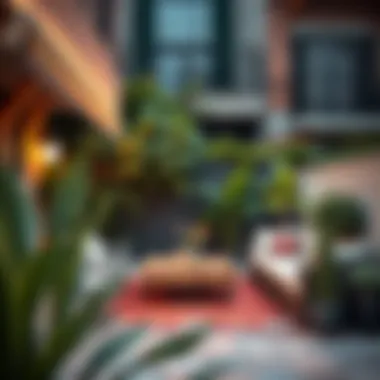

Ambient lighting serves as the foundation of your outdoor patio illumination. It’s the general light that fills a space, providing an even illumination without harsh shadows. Think of it as the common thread that ties all elements together. The warmth of soft ambient lighting can make a small patio feel cozy and inviting.
One of the key characteristics of ambient lighting is its capacity to create a peaceful atmosphere. It's beneficial because it sets the overall mood for any gathering, making it a popular choice for small spaces where every inch counts. String lights, wall-mounted fixtures, or even solar-powered lanterns can serve as effective ambient lighting options.
However, the downside may be a lack of focus in certain areas, so it’s often paired with other lighting types to ensure all corners are well-lit.
Task Lighting
Task lighting, as the name suggests, focuses on specific activities. Whether you’re reading, cooking, or playing games, this type of lighting ensures that you have ample light for those tasks. Fixtures like pendant lights over an outdoor dining area, or bright fixtures near BBQ stations are popular examples.
Perhaps the most important characteristic of task lighting is functionality. In a small outdoor area, where space is limited, task lighting can make everyday activities enjoyably practical. The unique aspect of this type of lighting is its focus; it allows you to easily direct beams where they are needed most.
On the downside, if not properly balanced, task lighting can create stark contrasts and lead to some areas feeling too bright while others remain dim. Thus, it is essential to integrate it well with ambient and accent lighting.
Accent Lighting
Accent lighting is the cherry on top, adding a touch of flair to your patio. It draws attention to specific features like garden sculptures, decorative plants, or cozy seating areas. Spotlights, wall sconces, and even candlelit arrangements can effectively achieve this.
The defining characteristic of accent lighting is its ability to create dramatic effects. It brings personality and style to your outdoor space, making it feel more curated and thoughtfully designed. This is why homeowners and designers alike find it to be a very beneficial addition.
However, it’s crucial to use accent lighting judiciously. Overdoing it can lead to a disjointed look, so balance is key.
Energy Efficiency
As much as aesthetics matter, energy efficiency cannot be overlooked. In small outdoor areas, homeowners often seek solutions that provide a great look without the hefty utility bills at the end of the month.
Opting for LED lights can drastically reduce energy consumption, making them an economic choice. Not only do they last longer, but they also emit less heat, which can be a significant bonus during warmer months.
Incorporating solar lights around the patio can complement your energy-efficient strategy. They harness the power of the sun, leaving you with a delightful glow by night, without touching your electric bill.
Textiles and Accessories
Designing a small outdoor patio can be a bit like fitting a square peg into a round hole, requiring thoughtful curation and attention to detail. It's here that textiles and accessories really come into play. They don’t merely add flair; they serve significant roles in enhancing comfort, usability, and aesthetic value. Selecting the right textiles can transform a limited space into a cozy retreat, making it feel larger and more inviting.
Choosing Weather-Resistant Fabrics
First off, it’s crucial to consider weather-resistant fabrics. These textiles stand up well against sun, wind, rain, and snow, ensuring they don't deteriorate after a season or two. Look for fabrics like solution-dyed acrylic or polyester blends. They resist fading and are easy to clean, making them appropriate choices for outdoor cushions or chair coverings.
"In the face of changing climates, opting for high-quality, weather-resistant materials is not just smart; it's essential."
When selecting fabrics, check for abrasion resistance, as pillows and cushions might take a beating. Moreover, mold and mildew resistance is a plus, particularly in humid climates. Understanding these elements will guide you in making informed decisions, ensuring your outdoor space withstands the test of time and elements.
Creating Comfort with Cushions and Rugs
Next up, let’s talk about how cushions and rugs play an integral role in crafting a comfortable atmosphere. Cushions are key to adding both comfort and style; they personalize the space to suit your taste. Select cushions with bold colors or patterns that draw the eye, making your small patio feel welcoming and vibrant.
- Think about the function: A thicker cushion might be more comfortable for lounging, while a firmer cushion could be better for dining experiences.
- Don't shy away from layering textures: A mix of smooth and rough fabrics can create visual interest.
In terms of rugs, they help anchor the space, giving it a more finished and cohesive look. Outdoor rugs, made of durable, weather-resistant materials like polypropylene, are ideal for this use. They define areas within the patio, guiding flow and usability, even in a compact setting.
Combining these elements not only enhances comfort but also fosters a sense of intimacy in small outdoor patios. Drawing attention to the textures and colors within your space can make all the difference in its overall appeal.
Color Schemes and Patterns
Designing a small patio is not just about fitting in furniture or scattering some plants around. The color schemes and patterns can shape the vibe of the entire space. Carefully chosen hues and motifs stimulate moods and impressions. They create an atmosphere that invites relaxation and conversation, making any limited area feel like a retreat.
Influencing Ambiance with Color
Color has a profound impact on how we perceive spaces. With small patios, the right shades can work wonders in creating an illusion of more space. Lighter colors, like soft whites, pale blues, and gentle yellows, tend to make an area feel larger and more open. These shades reflect light, dispersing it across the surface and brightening the overall ambiance.
On the flip side, darker hues bring depth and coziness. Think of deep greens or charcoal grays that evoke a sense of warmth. They can be used effectively to create intimate zones within a small patio. However, it's essential to balance these darker tones with adequate lighting to avoid making the space feel cramped.
Moreover, adding pops of color, through items like cushions, flowers, or outdoor rugs, can enliven the area and draw attention to features rather than the size. For example, a bold orange pot or vibrant red pillows can contrast beautifully with understated furniture, creating focal points that encourage exploration and engagement.
"Color is the keyboard, the eyes are the harmonies, the soul is the piano with many strings." - Wassily Kandinsky
Using Patterns to Enhance Space
Patterns can add visual interest and dimension to a small outdoor patio. This is crucial when working with limited areas, as they can transform plain surfaces into captivating visuals. Horizontal stripes, for instance, can trick the eye into seeing a more expansive width. Using striped outdoor rugs or cushions can give the illusion of a longer space.
Conversely, small, symmetrical patterns can add a touch of elegance without overwhelming the area. Geometric designs work especially well on textiles or even trellises. They can guide the eye upward, emphasizing height even in low ceiling environments.
When implementing patterns, it’s crucial to maintain unity. Combining too many conflicting designs can lead to chaos, rather than enhancing the environment. A consistent theme will provide a sense of order. For example:
- Choose a dominant pattern for a major piece, like a tablecloth.
- Select a secondary, subtler pattern for smaller items like cushions or throws.
- Don’t forget the flooring — patterned tiles can serve as a striking foundation while delineating space efficiently.
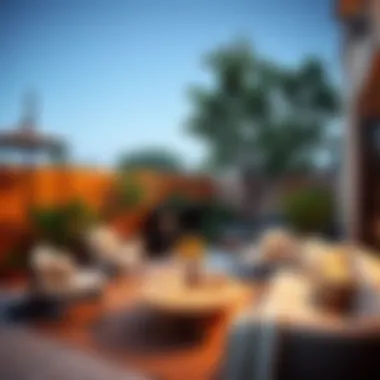

In sum, both color schemes and patterns are not only decorative elements but vital tools in maximizing small outdoor environments. They can cultivate an inviting and aesthetically pleasing atmosphere, allowing homeowners to escape into their personal outdoor oasis.
Privacy Solutions
Creating an inviting outdoor patio in a small space can sometimes come with its own set of challenges, mainly rooted in a lack of privacy. Patios often become the unwitting stage for passersby or noisy neighbors, leading to discomfort when trying to enjoy a quiet afternoon. Thus, incorporating effective privacy solutions is paramount for ensuring that your outdoor retreat serves its intended purpose: relaxation and leisure.
Privacy isn’t just about obstructing the view from the outside; it's also about fostering a sense of secluded comfort. You'd want to feel like your outdoor haven is a personal sanctuary, where you can sip that cup of tea or enjoy a book without feeling like you’re under a spotlight.
Here are some thoughtful privacy solutions that can transform an open patio into a cozy space:
Natural Barriers
Using natural elements to create privacy might be one of the most organic-feeling approaches. Plants can act as natural walls, providing both greenery and a gentle buffer against the outside world.
- Hedges: Dense hedges or shrubby plants can offer substantial height and cover. Consider using dwarf varieties that thrive in limited space but still provide a good visual barrier.
- Trellises with Climbing Plants: Utilizing trellises can give you vertical height while allowing for the growth of fragrant climbing vines like jasmine or clematis, which not only block out views but also add a delightful fragrance to your space.
- Planters with Tall Grasses: Ornamental grasses in large planters can offer a subtle windbreak while also creating a lush, inviting atmosphere. This is particularly effective in urban areas where concrete can make everything feel a bit too harsh.
Using Screens and Dividers
If you need something more structured, screens and dividers can be your best friends. They allow flexibility and can be adapted to fit your space's personality.
- Privacy Screens: Available in various materials—wood, bamboo, or even metal—these can be stylish additions that effectively block sightlines while maintaining airflow. Bamboo screens usually provide a tropical vibe that can elevate the aesthetics of your outdoor space.
- Movable Dividers: Instead of permanent installations, consider lightweight, movable screens. This allows for adjusting the layout depending on your needs or activities. You can easily push them aside for gatherings or shift them to create more privacy when desired.
- Curtains: Outdoor drapes can provide an elegant solution. They soften hard edges and offer flexibility. You can tie them back when not in use or pull them closed for a more private ambiance. Choose weather-resistant fabrics to ensure they withstand the elements.
Maintenance Considerations
Caring for small outdoor patios is a crucial aspect that cannot be overlooked. In many ways, maintenance ensures the longevity and aesthetic appeal of your outdoor space. When you have a limited area, the value of each piece of furniture and design element cannot be overemphasized. Neglecting regular maintenance could lead to premature wear and tear, which is particularly disappointing when space is already at a premium.
Keeping the patio clean and well-maintained is also essential for hygiene and safety purposes. Dirt, debris, and grime can accumulate quickly, especially in smaller areas where fewer elements might be present. This can lead to slippery surfaces or a habitat for unwanted pests. Therefore, regular maintenance is not just about improving the appearance; it’s also about ensuring that your outdoor retreat can be enjoyed without worry.
Cleaning and Care for Outdoor Furniture
The furniture chosen for your small patio doesn't just need to be stylish; it must also be easy to clean and maintain. A good rule of thumb is to opt for materials that are specifically designed for outdoor use. For instance, aluminum or treated wood require significantly less upkeep compared to untreated materials.
- Routine Cleaning: It's advisable to sweep your patio regularly to remove dirt and leaves. For deeper cleans, a mix of mild detergent and water can do wonders. Just be sure to rinse well to avoid soap residue.
- Inspecting for Damage: Keep an eye out for any signs of deterioration, such as rust or cracking. For wooden furniture, consider applying a sealant once a year to prevent moisture damage.
- Storage: When not in use, small pieces such as cushions or outdoor fabrics should be stored properly. Using a waterproof storage bag will keep them dry and ready for the next sunny day.
- Protective Covers: Invest in covers that fit snugly over your furniture. This can add a layer of protection from the elements during harsh weather.
By treating your outdoor furniture with care, you not only preserve its durability but also make it easier to enjoy your small patio space.
Seasonal Preparation
As the seasons change, so too does the approach to maintaining your patio. Preparing your space for fluctuations in weather ensures that it remains a viable retreat year-round.
- Spring Cleaning: As nature wakes from its winter slumber, it’s time to conduct a thorough clean. Remove any debris that may have accumulated over the colder months and check for signs of wear on your furniture.
- Summer Ready: During the warmer months, increased usage means your patio will likely gather more dirt. Regularly check that your plants are thriving and that drainage systems are clear. A little routine care prevents large messes later on.
- Fall Maintenance: With the leaves falling, it’s crucial to keep your patio clear to avoid gradual buildup that can stain surfaces. If you have plants, consider bringing any sensitive ones indoors as temperatures drop.
- Winterization: In many climates, winter can be harsh. If you live in a region that experiences snowfall, consider storing your outdoor furniture inside to protect it from the elements. Also, consider installing a windbreak if your patio is exposed to harsh conditions.
"An ounce of prevention is worth a pound of cure." Taking the time to perform seasonal checks can save you hours of work down the line.
By keeping up with maintenance and seasonal preparations, homeowners not only protect their investments but also contribute to the overall beauty and functionality of their small outdoor patios.
Examples of Successful Small Space Patios
Designing for small outdoor spaces brings its own set of challenges but offers immense opportunities for creativity and functionality. When we examine examples of successful small space patios, we uncover practical solutions that not only maximize the limited area but also exude style and comfort. These examples shed light on how homeowners can transcend spatial constraints and create inviting retreats.
Case Studies
A look into real-world applications can help clarify how design choices can optimize small patios. For instance, consider a compact city townhouse with a narrow balcony. By incorporating a built-in bench with storage beneath it, the homeowner created seating that doubled as a place to store gardening tools or cushions. This simplicity in design showed that even with limited space, one can provide both comfort and utility. This approach encourages people to think beyond traditional seating arrangements.
Another compelling case is a tiny backyard that leveraged a multi-tiered layout. By building planter boxes at different heights, this space turned a simple patio into a flourishing garden oasis. The vertical space enhacnes visual perspective while allowing for diverse plant placements. Notably, it also allowed for a charming seating area beneath a small pergola that provided a cozy escape from the sun. This showcases how strategic layering transforms ordinary dimensions into extraordinary experiences.
Design Inspirations
Besides specific case studies, inspiration can stem from design philosophies that encourage unique views and uses of space. One illustrative concept is the use of light colors on furniture and décor. In a small patio where light might be scarce, opting for pastel shades can create an impression of more space while also reflecting natural sunlight, giving a soothing and airy feel.
In urban environments, consider adding a modular furniture set. These pieces can be rearranged to fit various gatherings or occasions, from family barbecues to intimate dinners. By choosing items with clean lines and minimalistic designs, one can prevent the patio from feeling cluttered, which is often a common pitfall in small areas.
Another idea to mull over is the incorporation of string lights and lanterns. Not only do they create a warm, inviting atmosphere in the evenings, but they also highlight the patio's charm without taking up space. By integrating technology smartly, like solar-powered lights, one can blend contemporary conveniences with stylish touches.
By exploring these successful examples and deriving inspiration from them, future designs for confined outdoor areas can become appealing and functional. The emphasis on innovative solutions serves as a reminder that with a little planning, even the most cramped outdoor spots can flourish into personalized havens.
Future Trends in Small Outdoor Areas
As urbanization grows and living spaces shrink, optimizing small outdoor areas becomes crucial. Understanding future trends in this realm allows homeowners and designers to stay ahead of the curve. Garden design isn’t solely about aesthetics; it’s about creating functional spaces that cater to modern lifestyles. With a focus on efficiency and style, recognizing these trends can inspire innovative and practical solutions.
Innovative Design Concepts
- Biophilic Design: More than just a buzzword, biophilic design emphasizes the connection between nature and people. Integrating natural elements into small patios can create calming environments. This may include using natural materials such as wood or stone, and even incorporating water features, which can have a soothing effect, ultimately enhancing the outdoor experience.
- Modular Design Elements: Flexibility is key when space is tight. Modular outdoor furniture allows for customization and adaptability. Furniture pieces that can be separated, reconfigured, or stacked away make small gardens multi-functional. This type of design adapts to various uses, whether hosting a small gathering or enjoying a quiet evening alone.
- Sustainable Practices: The shift towards sustainability isn't just a phase—it's becoming standard practice. Using recycled materials, rainwater harvesting systems, and composting options in small outdoor areas can minimize environmental footprints. These innovations not only contribute to eco-friendliness but also attract environmentally-conscious homeowners.
- Smart Space Utilization: Creative yet practical approaches to utilizing vertical space can dramatically change the look and feel of small patios. Vertical gardens or wall-mounted planters bring greenery into limited spaces without sacrificing floor area. Furthermore, integrating trellises or pergolas allows homeowners to enhance their outdoor experiences upward rather than outward.
"Designing for small spaces is not merely about fitting everything in but maximizing the potential of every inch."
Technology Integration
Integrating technology into small outdoor setups enhances the overall experience while making maintenance more manageable.
- Smart Irrigation Systems: Automated watering systems tailored for smaller gardens can save both water and time. Sensors gauge moisture levels, ensuring plants receive water precisely when they need it. These technologies streamline care and keep gardens thriving without unnecessary resource consumption.
- LED Lighting Solutions: LED lights improve visibility and safety. Additionally, they create a warm ambiance for evening gatherings without using a lot of energy. Innovative designs include solar-powered options, making them even more suitable for eco-friendly approaches in smaller spaces.
- Outdoor Speakers and Connectivity: Wireless technology allows for seamless music streaming, enhancing outdoor enjoyment. Builders are designing furniture with built-in Bluetooth speakers, transforming everyday seating into engaging entertainment hubs. This integration turns patios into lively atmospheres for guests and family alike.
- Virtual Reality Planning Tools: Homeowners can visualize how their small patios could look before committing to any design. VR tools help identify potential layout changes and aesthetics, reducing mistakes and enhancing satisfaction with final results.
The trends on the horizon indicate that small spaces will become increasingly connected, both environmentally and technologically, helping to redefine how we interact with outdoor living areas. Homeowners and designers alike need to embrace these innovations, crafting unique outdoor experiences that reflect individual styles.
